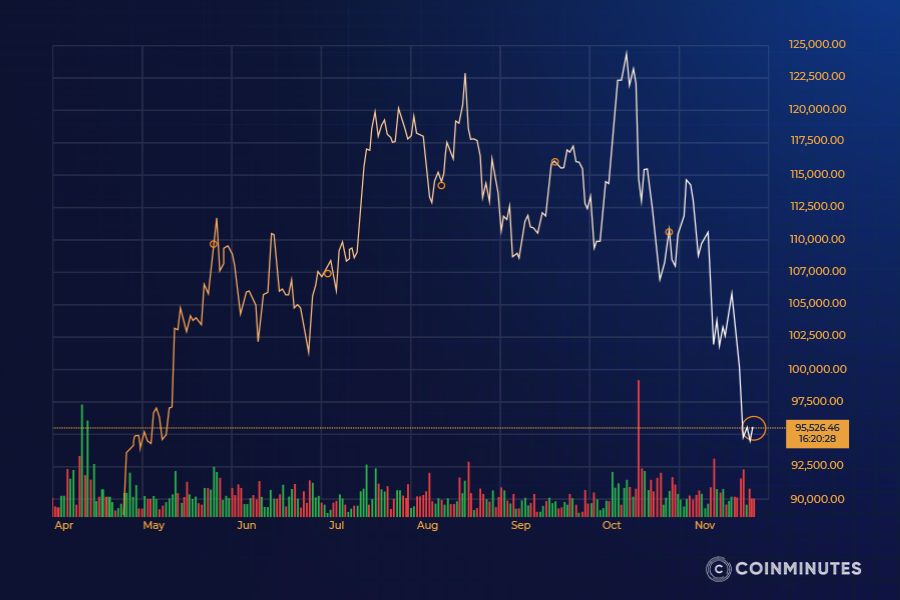Bitcoin in December 2025: Consolidation Below $100K or Calm Before the Storm?

Let's have a look at Bitcoin.
At the moment, the "king of cryptocurrency" appears to be delaying its next move. After a spectacular run to $120,000, Bitcoin has dropped to around the $95,000 level. The whole crowd is asking the same question: Is it just a pause before the rally continues, or a cautious signal of a crash to come?
If you only consider the figures, the market is like a spring that is tightly wound and ready to burst. When the situation is so quiet and there are strict limits, it usually means that a big move is coming. The big question is: which way is it going to be?
Weighing the figures, what can we infer about December?
Technical Picture: The Battle at the Halfway Line
The most significant instrument on the price graph right now is Fibonacci retracement position—basically, a psychological meter that measures the general sentiment of the crowd. After an initial strong upward move (from $70,000 to $120,000), the price usually retraces to take a rest.
The 50% level, or halfway point, is at $95,000 to the dollar. That is exactly where the price is now. A tug-of-war between two perfectly balanced forces.
How about moving averages? The price is currently below the 50-day moving average (around $98,500). It is a little bit worrying, as if an athlete who is running below his normal pace and now needs to get over this obstacle. Nevertheless, the 200-day long-term average is still far below at around $78,000, indicating that the bigger picture is still good.
There is another signal coming from the Bollinger Bands. Think of two elastic bands that wrap around Bitcoin's price. At the moment, these bands are very tightly squeezed. The "bottleneck" phenomenon, which is almost always followed by an explosive move in the price, is very close to being recognized here by the investing community.

Bitcoin price chart. (Source: TradingView)
Network Fundamentals: Old Hands Hold Firm, Newcomers Flee
Analyzing the network of Bitcoin beyond the price charts (on-chain data) gives a better understanding of the situation.
The MVRV Z-Score has come down from 5.5 to 4.0. This is a metric that defines the market "heat." At $120,000, Bitcoin was accompanied by this tool sending a red alarm, which meant too much enthusiasm. At present, the temperature has dropped significantly. This is good news. It indicates that the speculative frenzy has gone and that the market is more stable.
Investor behavior is even more fascinating. The data reveal that the people who have purchased Bitcoin recently (usually referred to as "weak hands") are selling at a loss. They are in a state of terror. Although this sounds terrible, in reality, it is a positive sign because, historically, it is at the moment when the less committed participants are forcibly disengaged that prices make their bottom and start to rise.
At the same time, veteran "HODLers" - those who have been holding Bitcoin for years - are still intact. The amount of Bitcoin available on exchanges (where people deposit for selling) is at a five-year minimum. There is no one waiting in line to dump their shares.
The Final Variable: The Fed Meeting
By and large, Bitcoin is performing well from a purely internal, metrics-based standpoint. However, December still has that final boss battle: the last Federal Reserve meeting of the year.
The Fed is the one who decides interest rates and thus whether money will be easy or tight:
In case the Fed decides to be "hawkish" (increasing the rates to have a better control over inflation), it will be a catastrophe for risk assets such as Bitcoin. The prices of these assets might go down.
If they indicate a "dovish" stance (easing the monetary policy), then it is a rocket to take the crypto market to new heights.
In fact, all the lovely technical analyses may be irrelevant if the Fed decides to go in a totally different direction.
Two Scenarios for December
How the events unfold is somewhat of a mystery. However, two distinct paths are pretty evident.
Scenario 1: Bullish Breakout. This case finds its strongest argument in the Fed data off the chain. In the case of a non-negative Fed announcement, Bitcoin will employ the $95,000 mark as a trampoline, leap across the $105,000 threshold, and the coiled spring will fly upwards with great impact. In that instance, the new goal would be to test the $120,000 level of the high again with a potential run to $135,000 even.
Scenario 2: Bearish Shakeout. This would be the case if we had a deterioration of the macroeconomic news and a breakdown at $95,000 level. The spring is going to be let loose downwards if the price goes under $90,000. The next stop would probably be the long-term average around $78,000. Not terribly devastating, but still quite unpleasant.
CoinMinutes’ Take
The way Bitcoin is interacting at present is somewhat similar to a compressed spring. It's not "boring" - rather, it's accumulating energy. Long-term holders continue to be loyal, whereas newcomers are getting frightened out.
That's largely because the network is healthy, so the internal metrics are quite positive. However, it is still a risky move if you decide to place a big bet before the Fed meeting.
It is very important that you watch these two figures: $95,000 (floor) and $105,000 (ceiling). The one that will be broken first will probably be pointing the way for the December trend. Don't lose your cool.
Disclaimer: This market analysis is for informational purposes only, NOT financial advice. Cryptocurrency is a high-risk game. Never invest money you cannot afford to lose, and always do your own research (DYOR).
 English
English
 Vietnamese
Vietnamese








